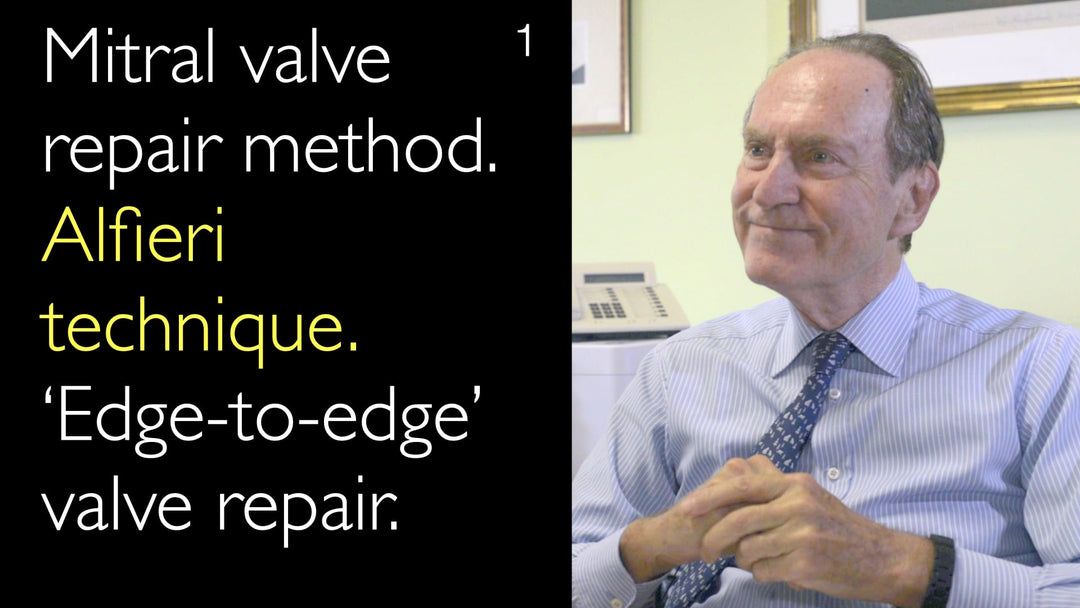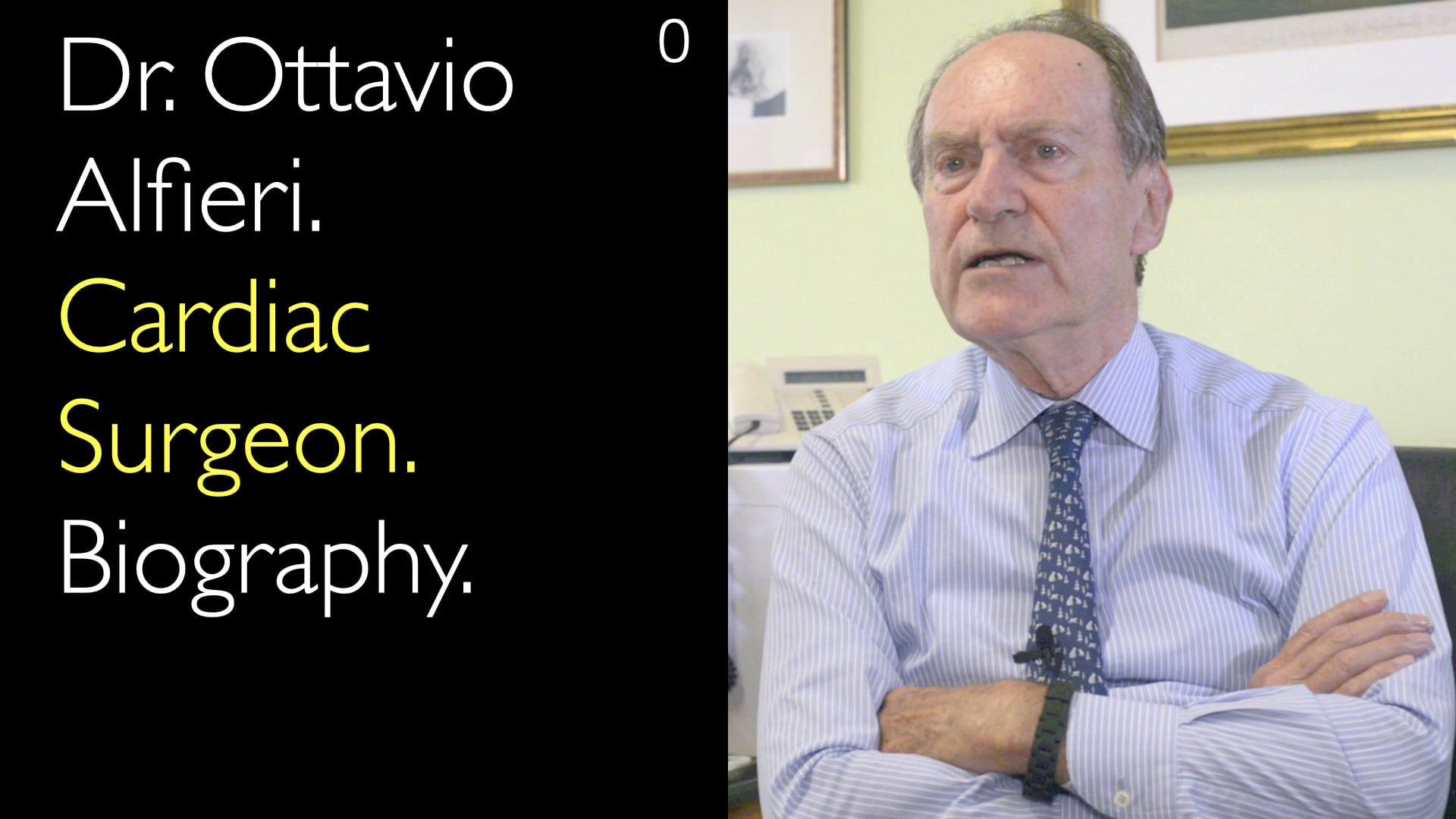Leading expert in mitral valve repair, Professor Dr. Ottavio Alfieri, MD, discusses the development and application of the Edge-to-edge technique, also known as the Alfieri technique. This innovative method addresses mitral valve regurgitation by approximating the free edges of the mitral valve leaflets, effectively eliminating regurgitation. Initially introduced in 1991, the technique provides a solution for patients with anterior leaflet prolapse and other challenging anatomical conditions. Professor Alfieri highlights the importance of selecting appropriate patients for this method, emphasizing its effectiveness in cases of localized mitral insufficiency and functional mitral regurgitation. The Alfieri technique remains a valuable option among various mitral valve repair methods, offering excellent results for specific patient subsets.
Innovative Mitral Valve Repair: The Alfieri Edge-to-Edge Technique
Jump To Section
- Development of the Alfieri Technique
- Patient Selection for Edge-to-Edge Repair
- Advantages of the Alfieri Method
- Functional vs. Structural Mitral Regurgitation
- Clinical Indications for Alfieri Technique
- Full Transcript
Development of the Alfieri Technique
Professor Dr. Ottavio Alfieri, MD introduced the Edge-to-edge technique in 1991 to address mitral valve regurgitation. This method involves approximating the free edges of the mitral valve leaflets at the point of regurgitation, effectively eliminating the issue. At the time, mitral valve repair was not widely practiced, with most surgeons opting for valve replacement. The Alfieri technique provided a new option, particularly for patients with challenging anatomical conditions.
Patient Selection for Edge-to-Edge Repair
Dr. Ottavio Alfieri, MD emphasizes the importance of selecting the right patients for the Edge-to-edge technique. Ideal candidates are those with localized mitral insufficiency, where the regurgitation jet can be precisely identified. By placing a surgical stitch at this point, a double orifice mitral valve is created, eliminating insufficiency. This method is particularly effective for patients with anterior leaflet prolapse and bi-leaflet mitral valve prolapse.
Advantages of the Alfieri Method
The Alfieri technique offers significant advantages in cases where conventional mitral valve repair methods yield suboptimal results. It is particularly beneficial for treating anterior leaflet prolapse and mitral valve prolapse at the commissure. Additionally, the technique is convenient for functional mitral regurgitation and situations where the mechanism of regurgitation is unclear.
Functional vs. Structural Mitral Regurgitation
Dr. Ottavio Alfieri, MD distinguishes between organic and functional mitral valve regurgitation. Organic regurgitation involves intrinsic abnormalities of the valve, whereas functional regurgitation occurs due to left ventricular dilatation and dysfunction, despite a structurally normal valve. Understanding this distinction is crucial for determining the appropriate surgical approach.
Clinical Indications for Alfieri Technique
The Alfieri technique is indicated for patients with isolated anterior leaflet prolapse, Barlow's disease with bi-leaflet prolapse, and prolapse at the mitral valve commissure. While the Edge-to-edge method can be extended to many patients, it is essential to consider other mitral valve repair techniques that may also provide excellent results. The Alfieri technique remains a valuable option for specific clinical scenarios.
Full Transcript
Dr. Anton Titov, MD: Let's start with the mitral valve regurgitation surgical treatment options. Thirty years ago, I developed a specific method of mitral valve repair. It's called the Edge-to-edge technique, now known as the Alfieri technique of mitral valve repair. Could you please tell us about your method of mitral valve repair? How did the Alfieri method of mitral valve repair come about, and how do you select the patients appropriately for your particular method and technique of mitral valve repair?
Dr. Ottavio Alfieri, MD: The Edge-to-edge technique approximates the free edges of the mitral valve leaflets exactly at the point of mitral regurgitation. It is done in such a way that mitral regurgitation is eliminated. We introduced that technique back in 1991. At that time, the repair of the mitral valve was not very much developed. It was not spread out among the surgeons, and only a few people were performing mitral valve repair. The rest of the surgeons around the world were invariably replacing the mitral valve for mitral regurgitation. With mitral valve repair, there are particular subsets of anatomy which are very good for repair. They are associated with excellent long-term results.
On the other hand, there are also some subsets of patients that present with anatomy which were not ideal for mitral valve repair, and the mitral valve repair in those cases was associated with suboptimal results. So, the technique was invented with the idea of making a repair possible with good results. It is used in those patients who could not have good results with the conventional methods of mitral valve repair at the time, specifically, patients who had anterior leaflet prolapse.
Patients with the anterior leaflet prolapse did not have good results with the techniques of mitral valve repair. On the other hand, with the technique of the edge-to-edge mitral valve repair, we could eliminate anterior leaflet prolapse. We could repair bi-leaflet mitral valve prolapse. These were incremental factors for suboptimal surgical operation results. There were other situations where the edge-to-edge mitral valve repair technique was really convenient. For instance, mitral valve prolapse at the site of the mitral valve commissure was also another very difficult entity to be treated with the mitral valve repair. And that became very easy with the edge-to-edge technique.
Also, for functional mitral regurgitation, the edge-to-edge technique was very convenient. This mitral valve repair also worked well for situations that are occurring occasionally, where you don't know exactly what is the mechanism responsible for mitral valve regurgitation. Then in those cases, the edge-to-edge mitral valve repair takes care of the problem.
Dr. Ottavio Alfieri, MD: As you said, in organic mitral valve regurgitation, there is an intrinsic abnormality and anatomic normality of the valve. On the other hand, in functional mitral regurgitation, the valve is intrinsically normal. The regurgitation of the mitral valve is only due to dilatation and dysfunction of the left ventricle. So, this is the difference.
Professor Alfieri: A patient is being considered for surgical treatment of mitral valve repair. They are discussing with their surgeon how a surgeon would approach the mitral valve treatment. A patient might have heard the edge-to-edge technique of mitral valve repair. Should a patient ask their surgeon, what about using the edge-to-edge technique of mitral valve repair? What would be the characteristics of a patient that would make it particularly well suited for the edge-to-edge mitral valve repair technique?
The ideal patient for the Alfieri technique is the patient who has a localized mitral insufficiency. So when you can identify exactly where the regurgitation jet is located, you can put a surgical stitch exactly at that point. You can create a double orifice mitral valve. This will, of course, eliminate the mitral valve insufficiency.
Professor Alfieri: You can extend the use of the edge-to-edge mitral valve repair method to many patients. But, of course, we also have other mitral valve repair techniques, which can have very good results. These heart valve repair methods can be used alternatively to the edge-to-edge Alfieri technique. Certainly, the isolated anterior leaflet prolapse is an excellent indication of the Alfieri technique. As well as Barlow's disease with the bi-leaflet mitral valve prolapse. As I also said, the prolapse corresponding to the commissure of the mitral valve can be treated very conveniently with the Alfieri technique.





